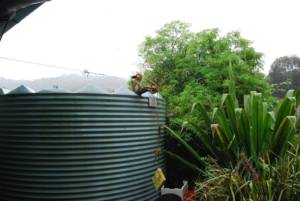 Lately, you might have heard about a concept called “rainwater harvesting.” It is the practice of collecting and storing rainwater in containers for the purpose of using it for different purposes in the home.
Lately, you might have heard about a concept called “rainwater harvesting.” It is the practice of collecting and storing rainwater in containers for the purpose of using it for different purposes in the home.
With the advent of indoor plumbing, this practice has faded away in most places, except for those areas that are remote and don’t have access to this particular technology. In recent times, this practice has resurfaced in many households all over the world, even in urban areas. More and more people are looking for ways to conserve water and reduce their month usage and bills. If you are one of these people, it would be best to orient yourself first with what the practice really entails so you’ll know what you’re getting into. Here are a few key terms you must know:
- Catchment area – This refers to the main area through which you can collect rainwater. In many households, one of the common options is the roof. The water collected in these areas are conveyed from the roof’s gutters to their intended containers through pipes or tubes. The best types of roofs for rainwater collection are asbestos or aluminum cement sheets, galvanized iron, slates, and tiles. Bamboo roofs are not so good because of the potential health hazards they present. Another alternative is a land surface catchment area, which is basically a less complicated way of harvesting rainwater. This involves catching rainwater from a land surface. This technique provides the opportunity of collecting rainwater from a bigger surface area.
- Conveyance system – The purpose of this system is to transfer the harvested rainwater from the catchment area to the storage containers. When setting up this system, keep in mind that when it first starts raining, dirty particles from the roof will be the first to get washed down the pipes. Clean rainwater will come later on in the storm. There are several ways you can screen the initial dirt. One way is by making use of a flap. This feature allows the dirty water to flow through the down-pipe while the cleaner water flows into the storage tank.
- Collection system – There are many types of storage containers. The most commonly used is a plastic barrel that simply collects water. However, this might not be able to give you the cleanest water available. The best types are storage tanks like those provided by Rain Water Tanks, as these kinds of containers have special features like a filtering system. Not to mention that they’re bigger so they allow you to catch or collect bigger quantities.
You can use rainwater for many purposes in your household. For one, you can use it to water the plants in your garden. Rainwater is better than regular tap water for plants because the former is not infused with hard minerals, unlike the latter. You can also use it to wash your laundry. As mentioned, rainwater is soft, so it’s gentler on the fabric of your clothes. You can also use it for other chores like washing the dishes. You just need to make sure that you filter the water you’ve collected so that they’re relatively clean.
Aside from reducing your household’s dependence on your municipal supply, rainwater harvesting can also greatly reduce your monthly bills. If you were to practice this on a regular basis, just imagine the huge savings you’ll get. It also provides you with a backup supply in case of drought.
For more information on how to reduce your water bill and conserve resources, check out 5 Reasons Your Water Bill Has Been Rising or contact us today!
The post All About Rainwater Harvesting and What It Can Do appeared first on Len The Plumber.
No comments:
Post a Comment